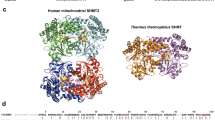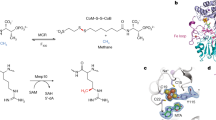Abstract
The predominant biosynthetic route to vitamin B6 is catalyzed by a single enzyme. The synthase subunit of this enzyme, Pdx1, operates in concert with the glutaminase subunit, Pdx2, to catalyze the complex condensation of ribose 5-phosphate, glutamine and glyceraldehyde 3-phosphate to form pyridoxal 5′-phosphate, the active form of vitamin B6. In previous studies it became clear that many if not all of the reaction intermediates were covalently bound to the synthase subunit, thus making them difficult to isolate and characterize. Here we show that it is possible to follow a single turnover reaction by heteronuclear NMR using 13C- and 15N-labeled substrates as well as 15N-labeled synthase. By denaturing the enzyme at points along the reaction coordinate, we solved the structures of three covalently bound intermediates. This analysis revealed a new 1,5 migration of the lysine amine linking the intermediate to the enzyme during the conversion of ribose 5-phosphate to pyridoxal 5′-phosphate.
This is a preview of subscription content, access via your institution
Access options
Subscribe to this journal
Receive 12 print issues and online access
$259.00 per year
only $21.58 per issue
Buy this article
- Purchase on Springer Link
- Instant access to full article PDF
Prices may be subject to local taxes which are calculated during checkout



Similar content being viewed by others
References
Eliot, A.C. & Kirsch, J.F. Pyridoxal phosphate enzymes: mechanistic, structural, and evolutionary considerations. Annu. Rev. Biochem. 73, 383–415 (2004).
Percudani, R. & Peracchi, A. A genomic overview of pyridoxal-phosphate-dependent enzymes. EMBO Rep. 4, 850–854 (2003).
Amadasi, A. et al. Pyridoxal 5′-phosphate enzymes as targets for therapeutic agents. Curr. Med. Chem. 14, 1291–1324 (2007).
Bilski, P., Li, M.Y., Ehrenshaft, M., Daub, M.E. & Chignell, C.F. Vitamin B6 (pyridoxine) and its derivatives are efficient singlet oxygen quenchers and potential fungal antioxidants. Photochem. Photobiol. 71, 129–134 (2000).
Daub, M.E. & Ehrenshaft, M. The photoactivated cercospora toxin cercosporin: contributions to plant disease and fundamental biology. Annu. Rev. Phytopathol. 38, 461–490 (2000).
Garrido-Franco, M. Pyridoxine 5′-phosphate synthase: de novo synthesis of vitamin B6 and beyond. Biochim. Biophys. Acta 1647, 92–97 (2003).
Fitzpatrick, T.B. et al. Two independent routes of de novo vitamin B6 biosynthesis: not that different after all. Biochem. J. 407, 1–13 (2007).
Burns, K.E., Xiang, Y., Kinsland, C.L., McLafferty, F.W. & Begley, T.P. Reconstitution and biochemical characterization of a new pyridoxal-5′-phosphate biosynthetic pathway. J. Am. Chem. Soc. 127, 3682–3683 (2005).
Raschle, T., Amrhein, N. & Fitzpatrick, T.B. On the two components of pyridoxal 5′-phosphate synthase from Bacillus subtilis. J. Biol. Chem. 280, 32291–32300 (2005).
Flicker, K. et al. Structural and thermodynamic insights into the assembly of the heteromeric pyridoxal phosphate synthase from Plasmodium falciparum. J. Mol. Biol. 374, 732–748 (2007).
Tambasco-Studart, M., Tews, I., Amrhein, N. & Fitzpatrick, T.B. Functional analysis of PDX2 from Arabidopsis, a glutaminase involved in vitamin B6 biosynthesis. Plant Physiol. 144, 915–925 (2007).
Neuwirth, M., Flicker, K., Strohmeier, M., Tews, I. & Macheroux, P. Thermodynamic characterization of the protein-protein interaction in the heteromeric Bacillus subtilis pyridoxalphosphate synthase. Biochemistry 46, 5131–5139 (2007).
Denslow, S.A., Rueschhoff, E.E. & Daub, M.E. Regulation of the Arabidopsis thaliana vitamin B6 biosynthesis genes by abiotic stress. Plant Physiol. Biochem. 45, 152–161 (2007).
Tambasco-Studart, M. et al. Vitamin B6 biosynthesis in higher plants. Proc. Natl. Acad. Sci. USA 102, 13687–13692 (2005).
Wrenger, C., Eschbach, M.L., Muller, I.B., Warnecke, D. & Walter, R.D. Analysis of the vitamin B6 biosynthesis pathway in the human malaria parasite Plasmodium falciparum. J. Biol. Chem. 280, 5242–5248 (2005).
Wetzel, D.K., Ehrenshaft, M., Denslow, S.A. & Daub, M.E. Functional complementation between the PDX1 vitamin B6 biosynthetic gene of Cercospora nicotianae and pdxJ of Escherichia coli. FEBS Lett. 564, 143–146 (2004).
Dong, Y.X., Sueda, S., Nikawa, J. & Kondo, H. Characterization of the products of the genes SNO1 and SNZ1 involved in pyridoxine synthesis in Saccharomyces cerevisiae. Eur. J. Biochem. 271, 745–752 (2004).
Ehrenshaft, M. & Daub, M.E. Isolation of PDX2, a second novel gene in the pyridoxine biosynthesis pathway of eukaryotes, archaebacteria, and a subset of eubacteria. J. Bacteriol. 183, 3383–3390 (2001).
Strohmeier, M. et al. Structure of a bacterial pyridoxal 5′-phosphate synthase complex. Proc. Natl. Acad. Sci. USA 103, 19284–19289 (2006).
Zein, F. et al. Structural insights into the mechanism of the PLP synthase holoenzyme from Thermotoga maritima. Biochemistry 45, 14609–14620 (2006).
Raschle, T. et al. Reaction mechanism of pyridoxal 5′-phosphate synthase. Detection of an enzyme-bound chromophoric intermediate. J. Biol. Chem. 282, 6098–6105 (2007).
Hanes, J.W., Keresztes, I. & Begley, T.P. Trapping of a chromophoric intermediate in the Pdx1-catalyzed biosynthesis of pyridoxal 5′-phosphate. Angew. Chem. Int. Edn Engl. 47, 2102–2105 (2008).
Hanes, J.W. et al. Mechanistic studies on pyridoxal phosphate synthase: the reaction pathway leading to a chromophoric intermediate. J. Am. Chem. Soc. 130, 3043–3052 (2008).
Anderson, K.S. et al. Observation by 13C NMR of the EPSP synthase tetrahedral intermediate bound to the enzyme active site. Biochemistry 29, 1460–1465 (1990).
Acknowledgements
This research was supported by grants from the US National Institutes of Health to T.P.B. (GM069618).
Author information
Authors and Affiliations
Corresponding author
Supplementary information
Supplementary Text and Figures
Supplementary Figures 1–9 and Supplementary Methods (PDF 1192 kb)
Rights and permissions
About this article
Cite this article
Hanes, J., Keresztes, I. & Begley, T. 13C NMR snapshots of the complex reaction coordinate of pyridoxal phosphate synthase. Nat Chem Biol 4, 425–430 (2008). https://doi.org/10.1038/nchembio.93
Received:
Accepted:
Published:
Issue Date:
DOI: https://doi.org/10.1038/nchembio.93



